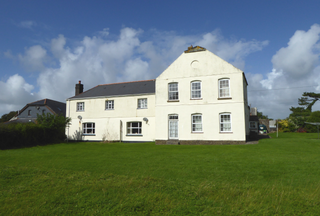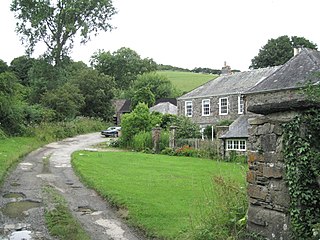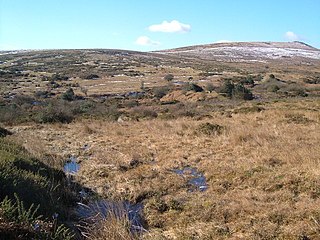
Culm Davy is a historic manor and present-day hamlet within the parish of Hemyock in Devon. [2]

Culm Davy is a historic manor and present-day hamlet within the parish of Hemyock in Devon. [2]
The estate of Cumbe is listed in the Domesday Book of 1086 as one of 27 Devonshire holdings of Theobald FitzBerner, [3] an Anglo-Norman warrior and magnate, one of the tenants-in-chief in Devon of King William the Conqueror. His tenant was Oliver, [4] who held three of FitzBerner's Devonshire manors, the others being Widworthy and Marwood. [5]
The manor subsequently became a possession of the feudal barony of Great Torrington. The 13th century Book of Fees records that the manor was held from the feudal barony by David de Wydworth (fl. tempore King Henry III (1216–1272) [6] (alias de Widworthy), [2] and was called after him either "Culm Davy" or "Culm Wydeworth". [2] He lived chiefly in Wales and was a younger son of Sir William de Widworthy of Widworthy, [6] in Colyton hundred, also a Domesday Book possession of Theobald FitzBerner tenanted by Oliver. [7]
Following the de Widworthy tenure, the manor was held by Sir John Wogan (during the reign of King Edward I [1272–1307]), then by Roger Corbet (during the reign of King Edward III [1327–1377]). [6]

From the reign of King Edward III (1327–1377) and following the Corbet tenure, the manor was held by John Bourman [6] (whose family name was later spelled "Bowerman"). It was the seat of his descendants for seven generations until the time of Pole (d.1635). [9] According to The Visitations of Hampshire 1530-1634; The publications of the Harleian Society 1913 Vol: LXIV (MS, Harl. 1544,fo.141b) the Bowerman family of Hemyock was descended from Nicholas Bourman of Brooke in the Isle of Wight, by his wife Elizabeth Russell, a sister of John Russell, 1st Earl of Bedford (c.1485–1555). [9] . However The College of Arms shows no pedigree from Nicholas Bowerman to John Bowerman. Research carried out on 10th November 2021 by the Rouge Dragon Pursuivant states the following:
"several college pedigrees were found to mention Nicholas Bourman who married Elizabeth Russell and with her had two sons named William and John. However, none of the pedigrees of Nicholas Bourman suggest that his son was the John Bowerman of Hemyock who married Jane/Joan Bykham. Indeed, the latest of Nicholas's pedigrees, which is dated to 1622 or 1634 and is the first to locate his descendants at Broke in the Isle of Wight, explicitly states that Nicholas's son John died without issue. Nicholas's line instead continued, at Broke, through the descendants of his eldest son William. If that is correct, there is no way that Nicholas's son John could be the same John Bowreman who resided at Hemyock, married Jane Bykham and had issue. It must be borne in mind that visitation pedigrees are not perfect and there is always the possibility that other documentary evidence could contradict them; but on the basis of the College records alone, there is no obvious relationship between Bowreman of Hemyock and Bourman of Broke."<Rouge Dragon Pursuivant></The College of Arms>
Two of his grandsons were Rev. John Bourman, a priest and confessor to the nuns of Canonsleigh Abbey, near Hemyock; and Rev. William Bourman, a priest and sub-dean and canon of Wells Cathedral in Somerset. [9] The Kerslake family acquired Culm Davy in about 1700 and then a Mr. Marsh of Wellington acquired it from the Kerslake family. [10] A series of deeds relating to Culm Davy dating from 1612 to 1778 are held at the Somerset Heritage Centre. [11]
In the early 19th century Culm Davy was the property of Mr. Henry Pook. [10]
Part of the mediaeval manor house of the Bowerman family survives within the structure of the present Culm Davy farmhouse, including the roof timbers. [12] Nearby is the small 15th century chapel of ease, which survives today, although it was heavily restored in 1860. [1] It contains an unusual mural monument "of the utmost primitiveness" for such a late date, to Anne Garvis (d.1705) of Ash Culm, comprising a classical entablature below an effigy lying on its side. [13]
Efford is an historic manor formerly in the parish of Eggbuckland, Devon, England. Today it has been absorbed by large, mostly post-World War II, eastern suburb of the city of Plymouth. It stands on high ground approximately 300 feet above the Laira estuary of the River Plym and provides views over long distances: to the north across Dartmoor, to the east and south-east across the South Hams. It consists predominantly of local authority and housing association properties. Before this land was built upon it was known as 'The Wilds of Efford', and was largely unspoilt countryside and marsh land. That a deer park may have been attached to the manor is suggested by the survival of the street name "Deer Park Drive".

Bucks Mills is a small English village within the parish of Woolfardisworthy on the north coast of Devon. It was anciently the mill of the manor of Bucks, anciently Bokish, Buckish, Bochewis etc., listed in the Domesday Book of 1086 as Bochewis. The village is within the North Devon Coast Area of Outstanding Natural Beauty and on the South West Coast Path.

Roborough is a village and civil parish 5.5 mi (8.9 km) from Great Torrington, in Devon, England. Situated topographically on the plateau between the Torridge and Taw Rivers, the parish covers 1,258 ha and contains a population of some 258 parishioners. It is surrounded by a pastoral landscape of rectangular fields, high hedges and scattered farmsteads.

The historic manor of Raleigh, near Barnstaple and in the parish of Pilton, North Devon, England, was the first recorded home in the 14th century of the influential Chichester family of Devon. It was recorded in the Doomsday Book of 1086 together with three other manors that lay within the later-created parish of Pilton. The manor lies above the River Yeo on the southern slope of the hill on top of which stand the ruins of the Anglo-Saxon hillfort called Roborough Castle. Part of the historic manor of Raleigh is now the site of the North Devon District Hospital.

The Domesday Book of 1086 lists in the following order the tenants-in-chief in Devonshire of King William the Conqueror:

Mohuns Ottery or Mohun's Ottery, is a house and historic manor in the parish of Luppitt, 1 mile south-east of the village of Luppitt and 4 miles north-east of Honiton in east Devon, England. From the 14th to the 16th centuries it was a seat of the Carew family. Several manorial court rolls survive at the Somerset Heritage Centre, Taunton, Somerset.
Floyer Hayes was an historic manor in the parish of St Thomas on the southern side of the City of Exeter in Devon, England, from which city it is separated by the River Exe. It took its name from the ancient family of Floyer which held it until the early 17th century, when it was sold to the Gould family. In the 19th century the estate was divided up and the manor house demolished. The parish church of St Thomas, situated a short distance to the west of the house, was burned down in 1645 during the Civil War, and was rebuilt before 1657. Thus no monuments survive there of early lords of the manor, namely the Floyer family.

Upcott is an historic manor in the parish of Cheriton Fitzpaine, Devon. The manor house, known as Upcott Barton is a mediaeval grade II* listed building notorious in the history of Devon as the place where in 1455 the murder of the lawyer Nicholas Radford by a mob directed by the Earl of Devon during the Wars of the Roses took place. In the grounds is a reproduction of an Iron Age roundhouse built circa 2014.

Washfield is a village, parish and former manor in Devon, England, situated about 2 miles north-west of Tiverton. The parish church is dedicated to St Mary the Virgin. It was within the jurisdiction of the historic West Budleigh Hundred.

Widworthy is a village, parish and former manor in Devon, England. The village is 3 1/2 miles east of Honiton and the parish is surrounded clockwise from the north by the parishes of Stockland, Dalwood, Shute, Colyton, Northleigh, and Offwell. The parish church is dedicated to St Cuthbert. Near the church is Widworthy Barton, the former manor house, which is largely unaltered from its early 17th century form. Widworthy Court is a mansion within the parish built in 1830 by Sir Edward Marwood-Elton to the design of G.S. Repton.

Webbery is an historic manor in the parish of Alverdiscott in North Devon, England.
Collacombe is an historic manor in the parish of Lamerton, Devon, England. The manor house survives as a grade I listed building, known as Collacombe Barton or Collacombe Manor (House).

Luscombe is an historic estate situated in the parish of Rattery in Devon.
The manor of Broad Hempston was a historic manor situated in Devon, England, about 4 miles north of Totnes. The present village known as Broadhempston was the chief settlement within the manor and remains the location of the ancient parish church of St Peter and St Paul.

Fardel is a historic manor in the parish of Cornwood, in the South Hams district of Devon. It was successively the seat of the Raleigh and Hele families. The surviving Grade I listed medieval manor house is situated about half-way between Cornwood and Ivybridge, just outside the Dartmoor National Park on its south-western border.
The manor of Alverdiscott was a manor situated in north Devon, England, which included the village of Alverdiscott.

Hareston is an historic estate in the parish of Brixton, about three miles from Plymouth in Devon. The mansion house built during the reign of King Henry VII (1485-1509) burned down partially in an accidental fire at the beginning of the 18th century, and in 1822 the surviving part, the Hall and Chapel, was being used as a farmhouse. It was described by Candida Lycett Green in her 1991 book The Perfect English Country House as: "The most forgotten Manor House Farm In England, untouched for hundreds of years, sits safely, impossible to find, down miles of private sunken lanes which in the spring brim with Campion, Bluebells, Purple Orchids, Primroses, Violets, Speedwell and Stitchwort. Wooded hills rise behind this, the quintessence of an ancient English Manor House".

Speccot is an historic estate in the parish of Merton in Devon, England. It was the seat of the de Speccot family, one of the oldest gentry families in Devon, which founded almshouses at Taddiport, near Great Torrington, Devon, in the 13th century. It is situated about one mile south-west of Potheridge, the seat of the Monck family from before 1287 to the late 17th century, who were thus close neighbours of the de Speccot family for many centuries. The present farmhouse known as "Speccot Barton" is Victorian and although no obvious traces of an earlier house survive, is marked "On Site of a Mansion" on the First Edition Ordnance Survey 25 inch map of 1880-99. The estate is today operated as a family-run sheep farm with six holiday cottages to let. A smaller house known as "Little Speccot" is situated on the approach lane to Speccot Barton.
Croker's Hele is an historic estate in the parish of Meeth in Devon, England.

Bagtor is a historic estate in the parish of Ilsington in Devon, England. It was the birthplace of John Ford the playwright and poet. The Elizabethan mansion of the Ford family survives today at Bagtor as the service wing of a later house appended in about 1700.